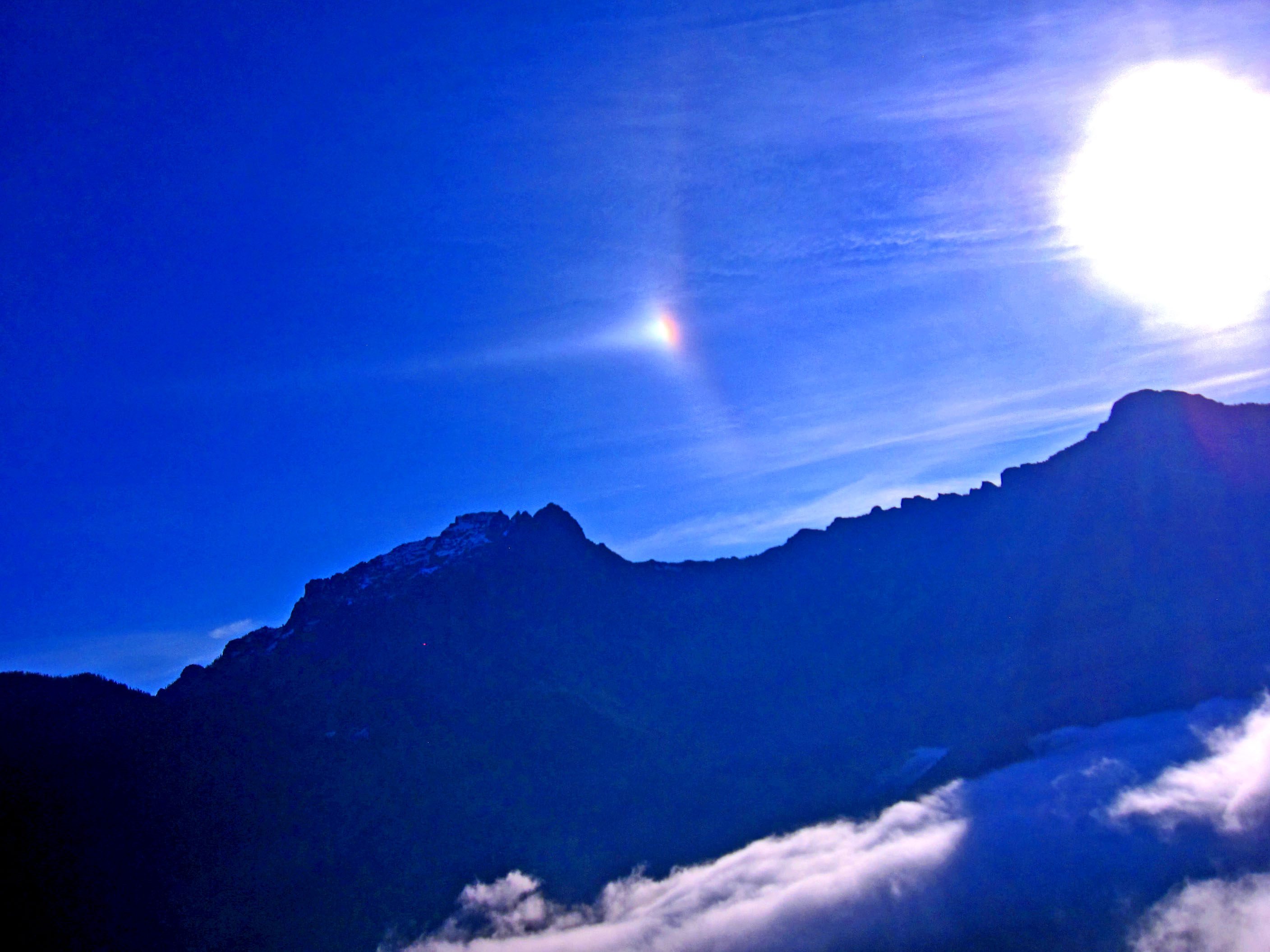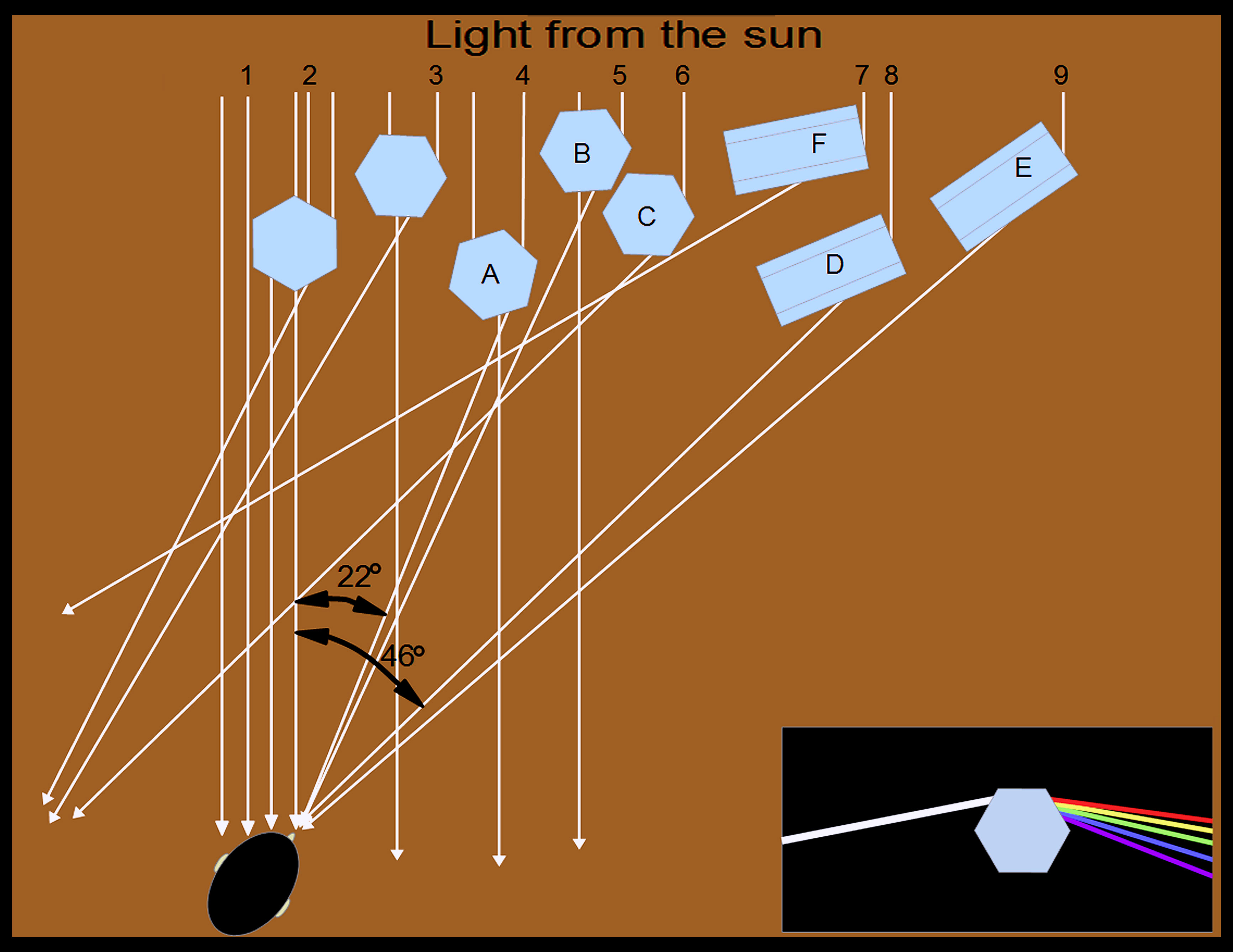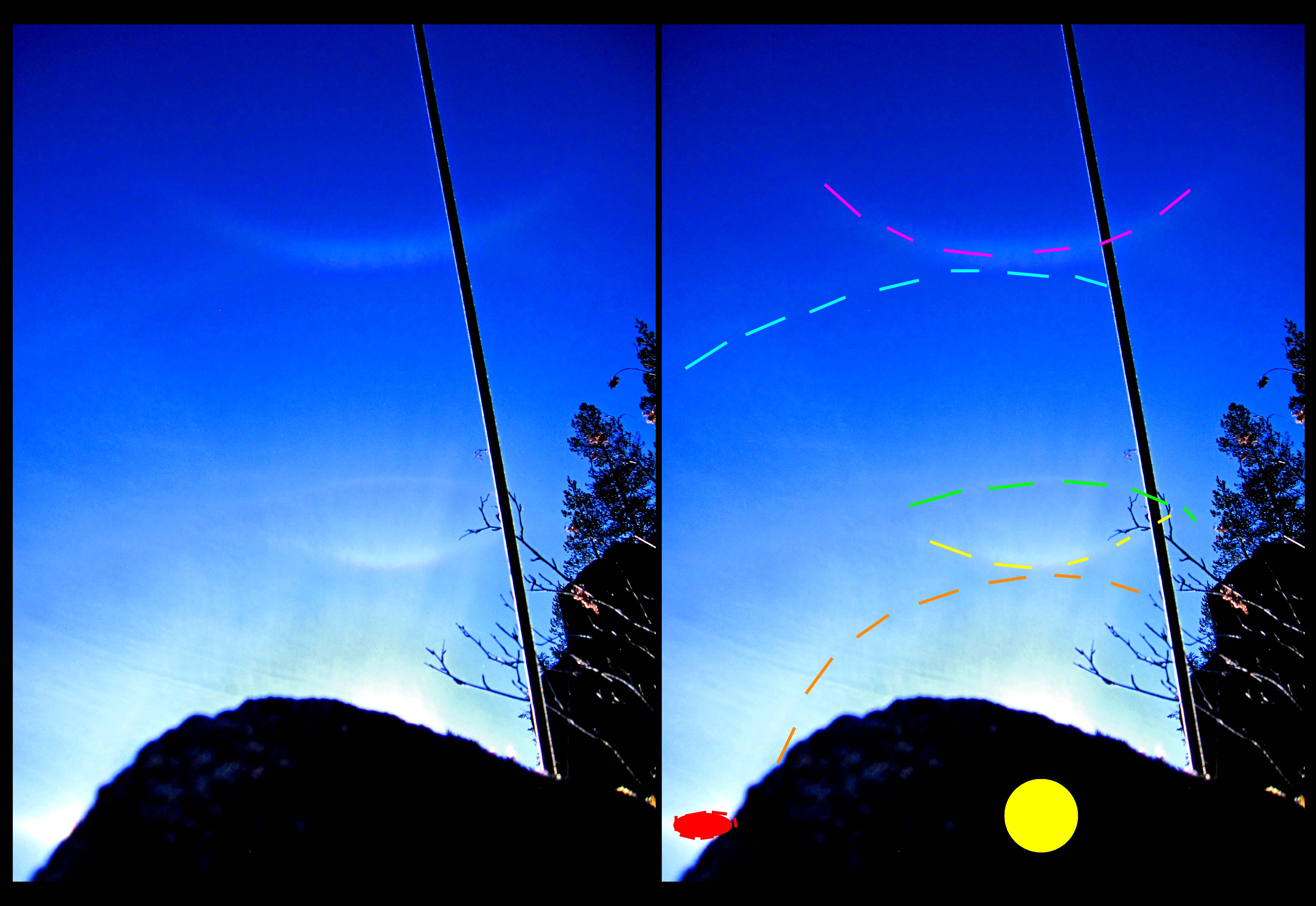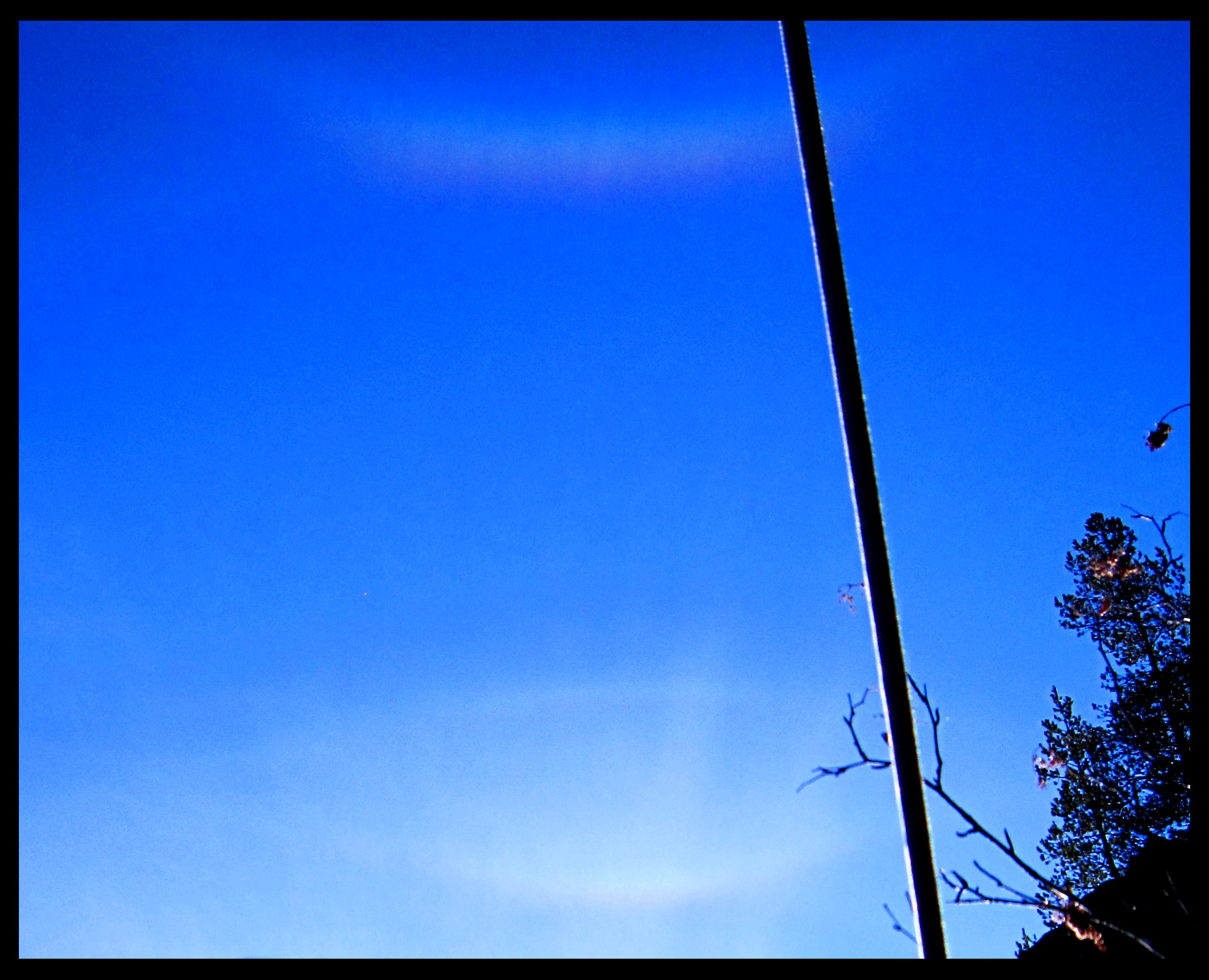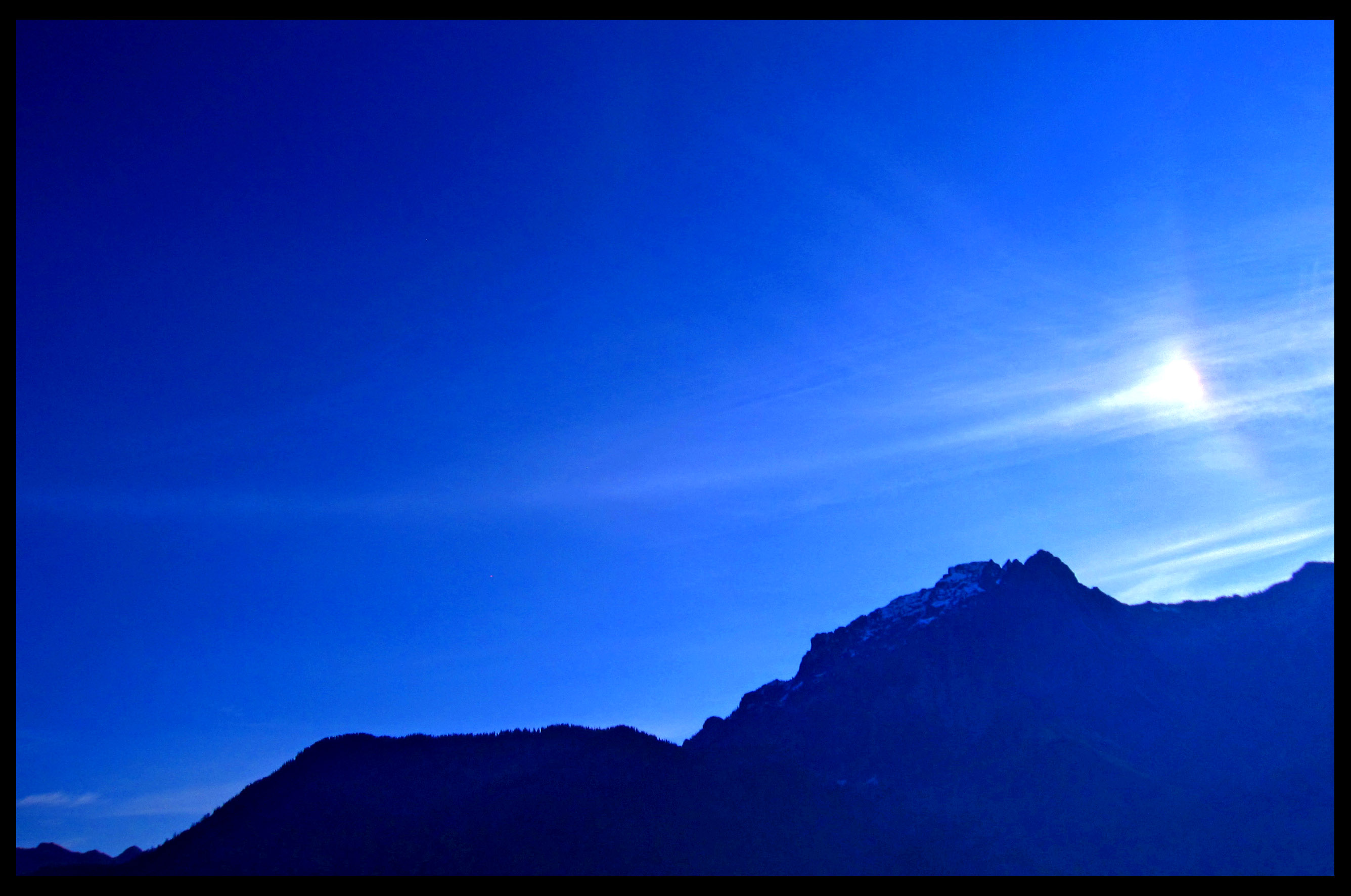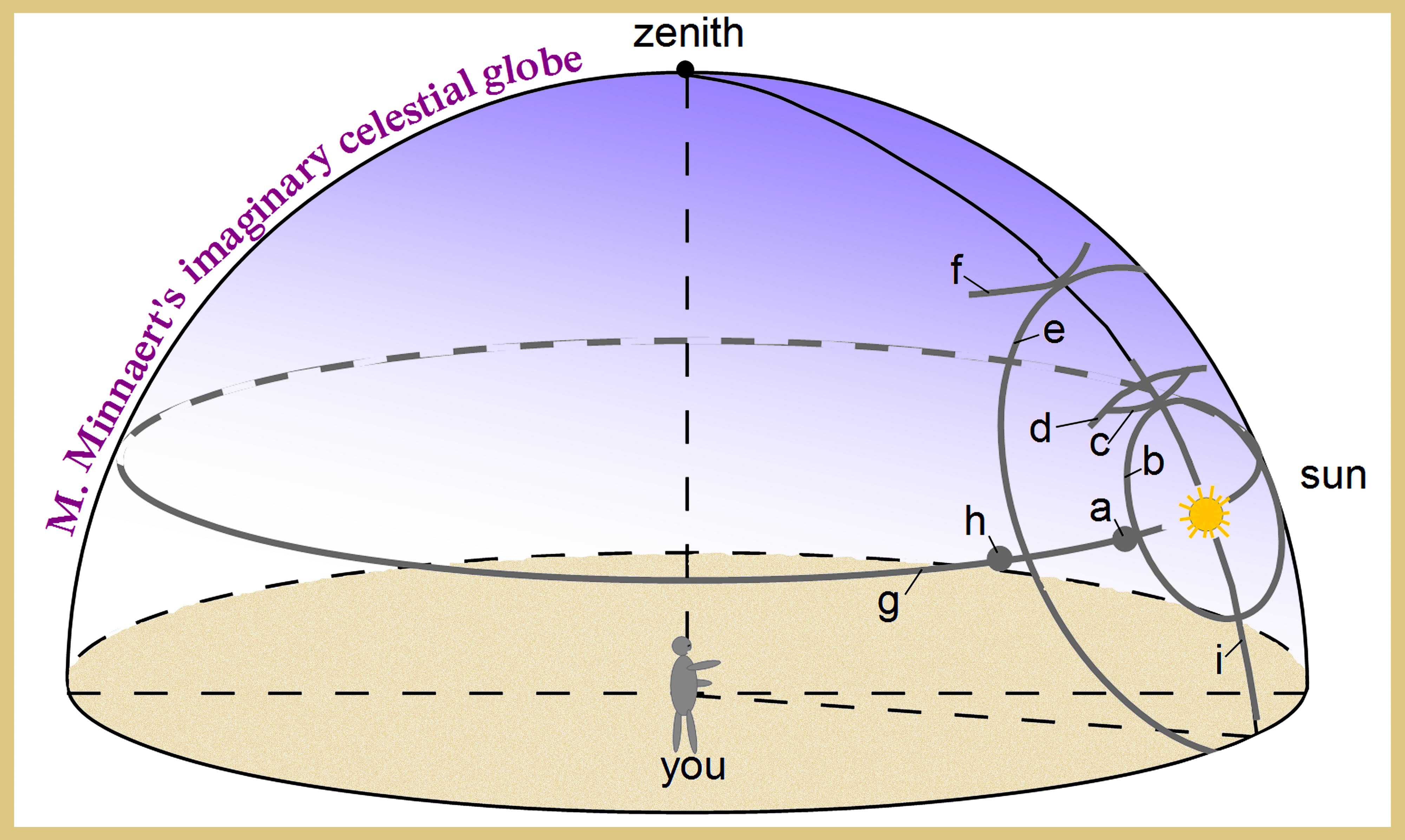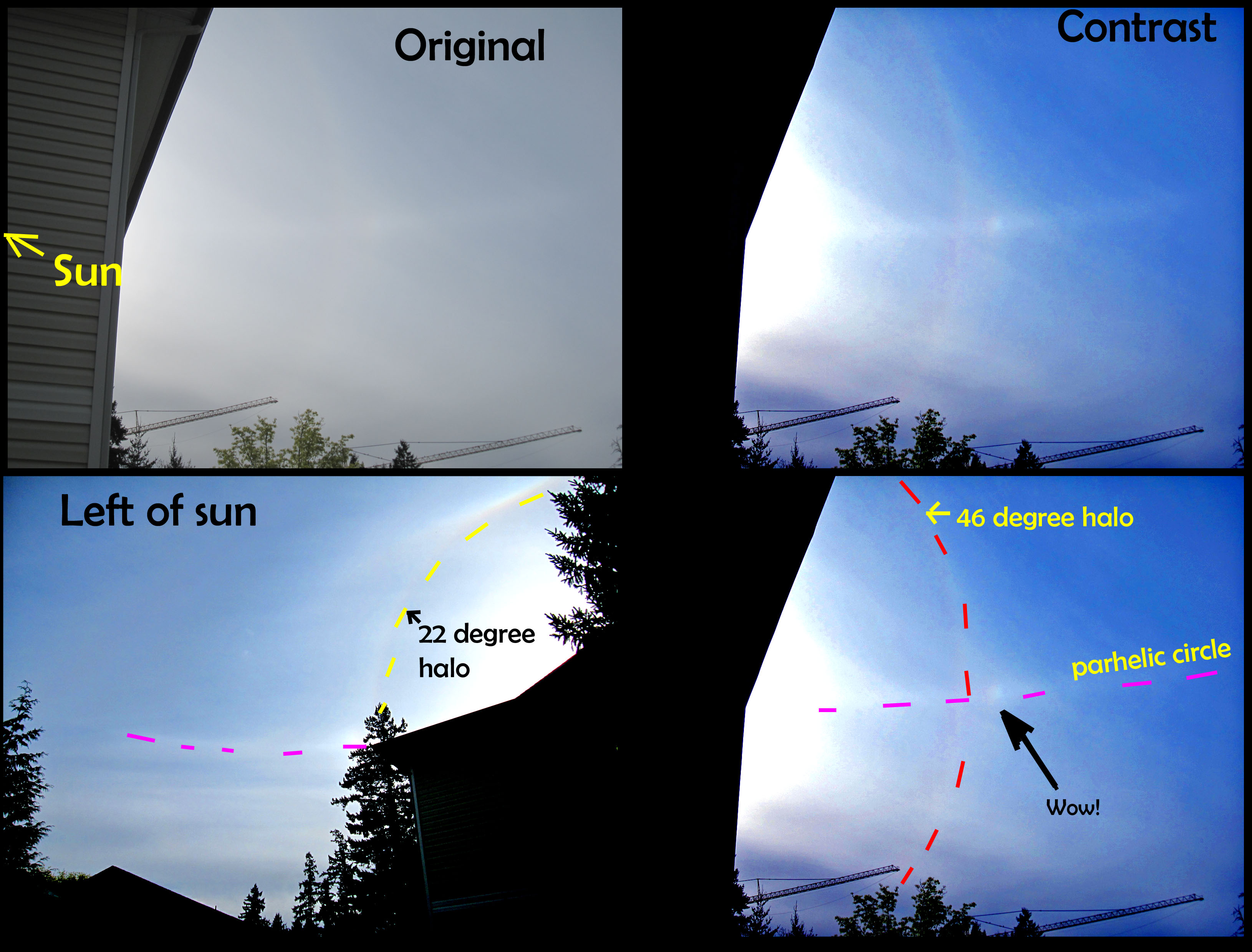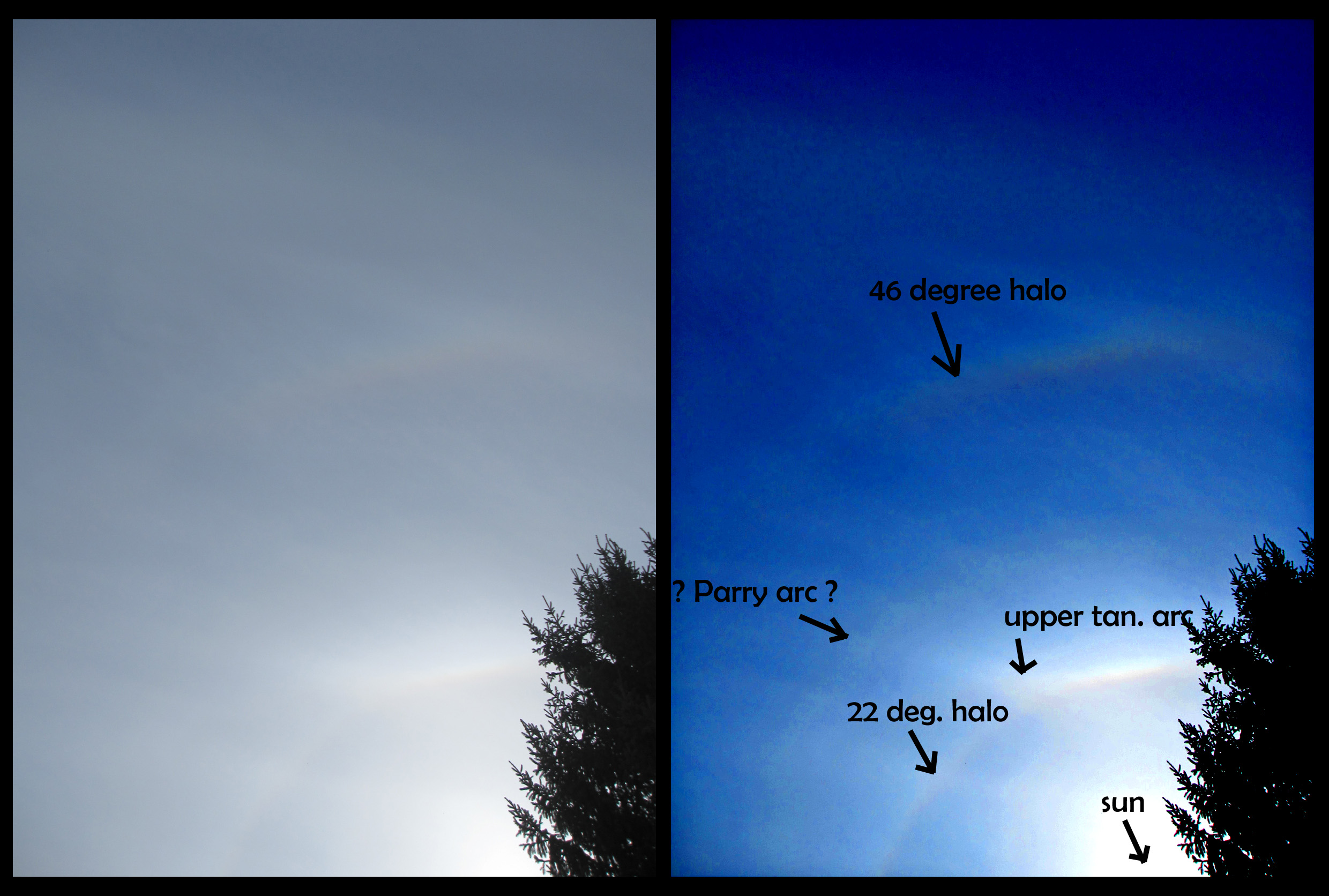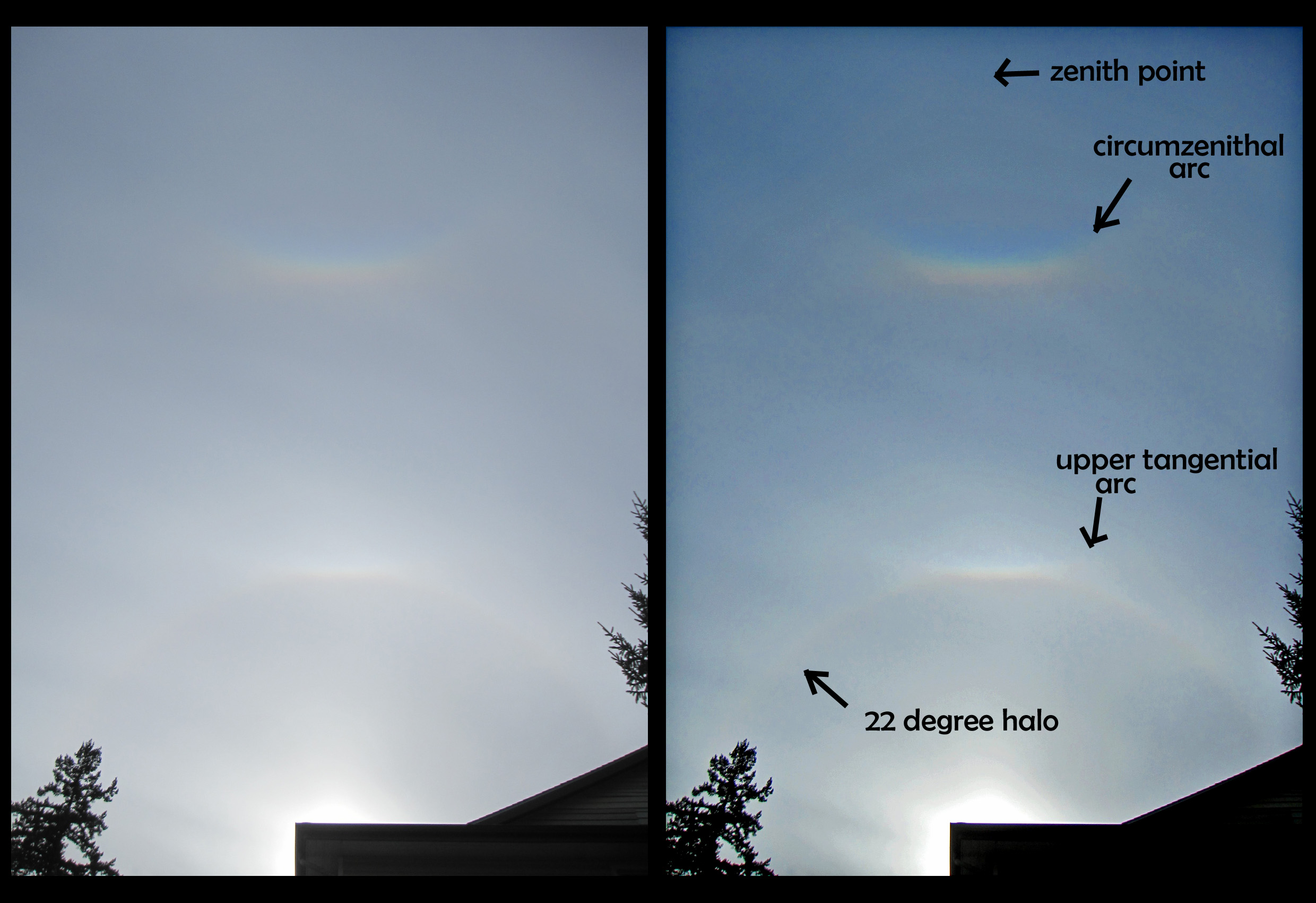| « The new ice-crystal-growth apparatus | The fun of shooting down your own theories » |
Halo in the sky? Uh, I don't see no halo...
After a few days of fine bright spring weather, the barometer falls and a south wind begins to blow. High clouds, fragile and feathery, rise out of the west, the sky gradually becomes milky white, made opalescent by veils of cirro-stratus. The sun seems to shine through ground glass, its outline no longer sharp, but merging into its surroundings. There is a peculiar, uncertain light over the landscape; I 'feel' that there must be a halo round the sun!
And as a rule, I am right.
The quote, from Minneart* describes a common ice-related atmospheric apparition. It appears in skies all over the world far more often than the rainbow, yet few notice it. As a graduate student, I read about halos and often looked for one, but didn't notice it myself until someone else pointed it out. As a post-doc in Boulder, I was out walking with Charles Knight, and I mentioned my lack of success. He glanced up near the sun, pointed, and said “why there's one right now”.
What I had missed in my readings had been the fact that most halos are rather indistinct and often incomplete circles. Indeed, now when I point out the most common one (the 22-degree halo) to someone nearby, they often don't see it. But occasionally, it is sharp enough (and colored) to the extent that anyone will see it if they bother to look up and glance toward the sun. And often it occurs with other ice-crystal apparitions that are even more obvious.
Last fall, while perched high on a rock face, belaying my partner up**, I saw such a vivid display.
The bright spot is called a “sun dog”, “mock sun”, or “parhelia”. They, one on either side of the sun, usually appear together with the 22 degree halo. Indeed, the sun dogs very nearly mark the spots where that halo intersects another arc called the parahelic circle. Their cause: horizontally oriented, tabular ice crystals.
To be more specific about the cause, consider the various paths of light from the sun. Imagine, as in the sketch below, that you (bottom), the crystals, and the sun (top) are all in the horizontal plane.
When a ray of light strikes an ice crystal, some of the light passes through. The drawing shows only the light passing through. Of this light, some goes straight through, while some bends, as light through a glass prism. Also, like a glass prism, the ice disperses the colors (bottom right corner), with the blues and violets bending more than the reds and yellows.
In rays marked 1 and 2, the light either passes straight through without hitting a crystal, or it goes straight through a crystal. If you made the mistake of looking in this direction, your eyes would be blinded by the sun. Now look to the side. Ray 3 hits a crystal on a prism face and deflects more than 22 degrees, passing to your left. You don't see this ray. Ray 4, on the other hand is hitting a crystal located in the right place in the cloud, and the crystal “A” is perfectly oriented crystal to deflect the ray by the minimum amount and reach your eye. Ray 5, slightly further right, does a similar thing with crystal B, but the crystal orientation is slightly “off”, meaning the ray is deflected more than that for 4. This ray also hits your eye. This occurs with numerous crystals, making this region near 22 degrees appear brighter than the surroundings. You see the sundog in this direction. Ray 6 hits a crystal further out, but the crystal orientation is too far off, and the ray misses you. If there are also crystals oriented like pencils on a table (D, E, and F), then a similar maximum of bending can occur through the end faces. In this case, the bright spot is near 46 degrees.
Now that you have the sundogs figured out, you can easily understand the 22 degree halo. In this case, consider that the cloud has crystals like A, B, and C at all elevations and all orientations (i.e., not just horizontal). So, everywhere that is 22 degrees from the sun will have a bright spot: 22 degrees above the sun (12 o'clock), 22 degrees below the sun (6 o'clock), 22 degrees left, 22 degrees right, and all clock positions in between. This is a circle. The same applies to the 46 degree case, but the 46 degree halo is much less common.
Is that a Parry arc I see lurking up there?
On that day, I saw other crystal displays. They were faint, but there.
The one at the top (marked with purple on the right side) is called the circumzenithal arc. When viewed by the eye, it can have rainbow-like colors. Right below it, and barely visible, is the 46 degree halo (marked light blue on right side). The upward-curving arc, marked yellow on right, is fairly common – look for it just touching the top of the 22 degree halo (orange on right, ultra faint). The sundog shown earlier, here partly blocked by the rock, is marked with a red oval. The one I had never seen before is marked in green. This is the vary rare Parry arc – indeed, I have not seen a case this distinct reported in the literature. The experts figure that this must be due to horizontally oriented pencil-shaped crystals with a flat prism face on top and bottom, exactly like the ones marked D, E, and F, in the previous drawing above.
The circumzenithal arc is one of my favorites. It is further from the sun, and thus easier on the eyes to view. The thing that really gives me pause though is the fact that the crystals that produce it must fall in nearly perfect alignment with the horizontal – like plates sitting on an invisible table. These are crystals A, B, and C in the drawing above, except the light path is different, entering the tops of the crystals and exiting their prismatic sides. Its prism-like colors show up a little better in the image below.
I was also very pleased to see a good segment of the parahelic circle extending out from the sundog:
Like the sundog and circumzenithal arc, the parahelic-circle crystals must stay very horizontal. The effect though is not from light bending through the crystals, but light reflecting off their sides.
The relation of these observable arcs are seen on Minneart's imaginary celestial globe:
This “imaginary celestial globe” is a hemispherical map to mark angles in the sky – you can imagine it as a transparent dome tent above wherever you happen to be, and the sun and whatever arcs and halos projected onto it at the same angle you see them in the sky. In the case above, the sun is about 40 degrees above the horizon. Note that the sun here is exaggerated – it subtends only an angle of about 0.5 degrees (curiously, nearly exactly the same angle as that of the moon).
The point marked “a” is the sundog, just slightly outside of the 22-degree halo at “b”. “c” and “d” are the upper tangential and Parry arcs, whereas “e” is the 46-degree halo. “f” is the circumzenithal arc, which is part of a circle around the zenith point directly overhead. “g” is the parahelic circle, which is a full circle around the zenith. In fact, the first time I ever saw the parahelic circle, it did make a complete circle as drawn on the globe. “h” is the corresponding sundog for the 46-degree halo, which is said to be very rare (but see below). Finally “i” is the sun pillar, which I showed in a previous blog posting.
This does not exhaust the arcs, halos, pillars, and parhelia, oh no. Many more exist and have been photographed. For example, when the sun is higher, a “circumhorizontal arc” can form just like the circumzenithal arc, except it will be below the sun, near the bottom of circle “e”.
It's happening again
Just a few days ago, the weather unfolded just as Minneart says at the opening of this post. A bright sundog appeared, then the upper tangential arc. The high, thin clouds moved in as I came home, at which point I looked up again. I could see part of the parahelic circle and “felt” like the 46-degree halo was lurking there, but it was hard to be sure my mind wasn't playing tricks on me. You can see these patterns a little better if you do not stare directly at them.
But on the camera, one has a very hard time seeing even the parahelic circle. However, with a little contrast and saturation adjustment, two other surprised were revealed:
The above left is the original camera image. It is hard to see anything. At right is the contrast-saturation -adjusted version. Not only is the parahelic circle clear, but so is the 46-degree halo. And what's that white dot further out? Why it is the extremely rare 46-degree sundog! I have never even seen a published photo of such a beast. Wow. At bottom left is the scene on the other side of the sun. Not as exciting, but you can make out the parahelic circle and 22-degree halo.
The same contrast-saturation adjustments made a few other patterns clearer:
In the above case, the top of the 46 degree halo, the upper tangent arc, and the 22 degree halo are distinct. In addition, it appears that the Parry arc is lurking (the “??” on the right side). I checked back on the display about 10 minutes later, and saw the beautiful colors of the circumzenithal arc.
So, what's the point of all this?
Nothing earthshaking, but displays like these may make your otherwise unremarkable day just a little more interesting. For a deeper appreciation, you can read up on the various crystals and light paths that produce these things.*** Hey, ever see a person get excited about seeing a rainbow? Well, there's way more stuff to see from ice...that person you point out a halo to might thank you and just become your new friend.
And who knows, you might be the first person to detect some new arc in the sky.
Do you want to see some of the strange tricks ice crystals play in the sky? It's not so hard if you know where, when, and how to look. I've given you a start on all three here.
-JN
*Marcel Minneart, The nature of light and color in the open air, Dover. I heard it said that he wrote much of the book while in a prison camp during the German occupation in the Netherlands during WW2.
**The account is given at
http://cascadeclimbers.com/forum/ubbthreads.php?ubb=showflat&Number=1114074
*** For more arcs and halos, see Robert Greenler's book "Rainbows, Halos, and Glories", Cambridge. Walter Tape also has a nice book about atmospheric halos.
